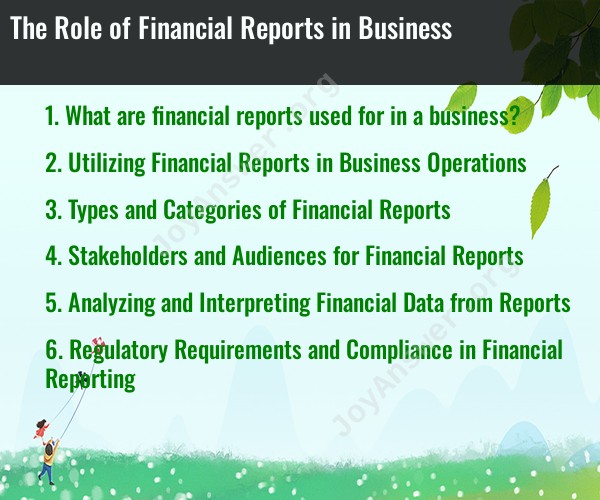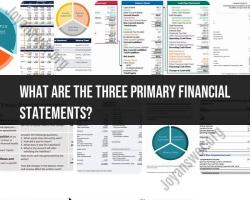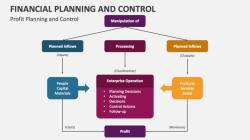What are financial reports used for in a business?
Financial reports play a crucial role in business for several key purposes. They provide a snapshot of a company's financial performance, health, and position at a specific point in time. Here are the main uses of financial reports in a business:
Financial Analysis and Decision-Making:
- Financial reports, such as balance sheets, income statements, and cash flow statements, are essential tools for analyzing a company's financial performance. They provide valuable insights into revenue, expenses, assets, liabilities, and equity. Business leaders and stakeholders use this information to make informed decisions about operations, investments, and strategies.
Performance Evaluation:
- Financial reports help evaluate a company's performance and its progress toward achieving its financial goals. By comparing current financial data to previous periods, businesses can identify trends, areas of improvement, and potential issues that need addressing.
Budgeting and Planning:
- Financial reports are used in the budgeting and planning process. They assist in setting financial goals and creating budgets for various departments and projects. The reports help align spending with revenue and identify areas where adjustments may be needed.
Investor Relations:
- Publicly traded companies use financial reports to communicate their financial performance to shareholders and potential investors. These reports help build investor confidence and attract capital. Transparency in financial reporting is crucial for maintaining trust with investors.
Credit and Lending Decisions:
- Lenders and creditors use financial reports to assess a company's creditworthiness and make lending decisions. A strong financial position and healthy financial ratios can result in better lending terms and lower interest rates.
Compliance and Regulation:
- Financial reports are required for regulatory and compliance purposes. Governments and regulatory bodies often mandate the preparation and submission of financial reports to ensure that companies adhere to accounting and financial reporting standards.
Tax Reporting:
- Financial reports are used for tax reporting and compliance. Accurate financial statements help businesses calculate their tax liability and file tax returns.
Stakeholder Communication:
- Financial reports are a means of communication with various stakeholders, including employees, suppliers, customers, and the broader community. Transparent and accurate financial reporting fosters trust and accountability.
Risk Assessment:
- Companies use financial reports to assess financial risks, such as liquidity risks, solvency risks, and market risks. By examining the financial data, businesses can make informed decisions to mitigate risks effectively.
Benchmarking:
- Financial reports allow businesses to benchmark their financial performance against industry peers or competitors. This comparison can highlight areas where a company may need to improve or where it excels.
Asset Valuation and Depreciation:
- Financial reports include information about the value of a company's assets and how they are depreciating over time. This data is critical for determining asset value and for financial planning.
Mergers and Acquisitions:
- Companies involved in mergers, acquisitions, or due diligence processes rely on financial reports to assess the financial health and value of potential targets. These reports are integral to negotiating terms and valuations.
Internal Management:
- Financial reports are used by internal management for day-to-day decision-making. They provide insights into the company's financial status, enabling managers to allocate resources efficiently and make informed operational decisions.
Financial reports serve as a comprehensive tool for understanding a company's financial health and performance. They are critical for transparency, accountability, and making sound financial and strategic decisions.
Utilizing Financial Reports in Business Operations
Financial reports are essential tools for business operations. They provide managers and other stakeholders with valuable insights into a company's financial performance, health, and position. This information can be used to make informed decisions about a wide range of business activities, including:
- Budgeting and forecasting
- Resource allocation
- Strategic planning
- Investment decisions
- Performance management
- Risk management
Types and Categories of Financial Reports
There are three main types of financial reports:
- Balance sheet: A balance sheet shows a company's assets, liabilities, and equity at a specific point in time.
- Income statement: An income statement shows a company's revenues, expenses, and net income over a period of time.
- Cash flow statement: A cash flow statement shows how a company has generated and used cash over a period of time.
In addition to these three main types of financial reports, there are a number of other specialized financial reports that companies may produce, such as:
- Statement of changes in equity: This report shows how a company's equity has changed over a period of time.
- Segment reporting: This report shows a company's financial performance by business segment.
- Sustainability reporting: This report provides information about a company's environmental, social, and governance (ESG) performance.
Stakeholders and Audiences for Financial Reports
Financial reports are used by a variety of stakeholders, including:
- Management: Management uses financial reports to track the company's performance, make informed decisions, and set strategic goals.
- Investors: Investors use financial reports to evaluate the company's financial health and performance before investing.
- Creditors: Creditors use financial reports to assess the company's creditworthiness before lending money.
- Analysts: Analysts use financial reports to research companies and make investment recommendations.
- Regulators: Regulators use financial reports to ensure that companies are complying with financial reporting requirements.
Analyzing and Interpreting Financial Data from Reports
To effectively use financial reports, it is important to be able to analyze and interpret the data they contain. This involves:
- Understanding the different types of financial statements and reports.
- Identifying key financial metrics and ratios.
- Comparing a company's financial performance to its own historical performance and to the performance of its peers.
- Identifying trends and patterns in the financial data.
Regulatory Requirements and Compliance in Financial Reporting
Publicly traded companies are required to file financial reports with the Securities and Exchange Commission (SEC) on a regular basis. These reports must be prepared in accordance with generally accepted accounting principles (GAAP).
Private companies are not required to file financial reports with the SEC, but they may still be subject to other regulatory requirements, such as those imposed by banks and other lenders.
Conclusion
Financial reports are essential tools for business operations and decision-making. By understanding the different types of financial reports, their audiences, and how to analyze and interpret the data they contain, businesses can make better decisions and improve their performance.













